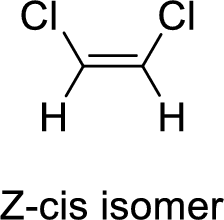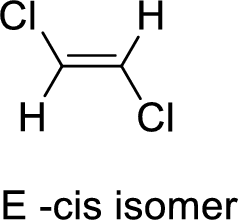
Chemistry: The Molecular Science
5th Edition
ISBN: 9781285199047
Author: John W. Moore, Conrad L. Stanitski
Publisher: Cengage Learning
expand_more
expand_more
format_list_bulleted
Concept explainers
Question
Chapter 6, Problem 12QRT
Interpretation Introduction
Interpretation:
The reason for those
Concept Introduction:
It is under the class of geometric isomer. It exists in
Cis isomers are termed as z-isomer and Trans isomers are termed as E-isomer.


Expert Solution & Answer
Trending nowThis is a popular solution!

Students have asked these similar questions
Using the following two half-reactions, determine the pH range in which $NO_2^-\ (aq)$ cannot be found as the predominant chemical species in water.* $NO_3^-(aq)+10H^+(aq)+8e^-\rightarrow NH_4^+(aq)+3H_2O(l),\ pE^{\circ}=14.88$* $NO_2^-(aq)+8H^+(aq)+6e^-\rightarrow NH_4^+(aq)+2H_2O(l),\ pE^{\circ}=15.08$
Indicate characteristics of oxodec acid.
What is the final product when hexanedioic acid reacts with 1º PCl5 and 2º NH3.
Chapter 6 Solutions
Chemistry: The Molecular Science
Ch. 6.2 - Write Lewis structures for (a) NF3, (b) N2H4, and...Ch. 6.3 - Prob. 6.1ECh. 6.3 - Prob. 6.2PSPCh. 6.4 - Prob. 6.2CECh. 6.4 - Write Lewis structures for (a) nitrosyl ion, NO+;...Ch. 6.5 - Prob. 6.4CECh. 6.5 - Prob. 6.5CECh. 6.5 - Prob. 6.4PSPCh. 6.6 - Prob. 6.5PSPCh. 6.6 - Use Equation 6.1 and values from Table 6.2 to...
Ch. 6.6 - Prob. 6.6CECh. 6.7 - Prob. 6.7PSPCh. 6.7 - Prob. 6.7CECh. 6.8 - Prob. 6.8PSPCh. 6.9 - Prob. 6.9PSPCh. 6.9 - Prob. 6.9CECh. 6.10 - Prob. 6.10PSPCh. 6.11 - Prob. 6.10ECh. 6.11 - Prob. 6.11ECh. 6.11 - Prob. 1CECh. 6.11 - Prob. 2CECh. 6.12 - Repeat Problem-Solving Example 6.11, but use N2...Ch. 6.12 - Use MO theory to predict the bond order and the...Ch. 6 - Prob. 1QRTCh. 6 - Prob. 2QRTCh. 6 - Prob. 3QRTCh. 6 - Prob. 4QRTCh. 6 - Prob. 5QRTCh. 6 - Prob. 6QRTCh. 6 - Which of these molecules have an odd number of...Ch. 6 - Prob. 8QRTCh. 6 - Prob. 9QRTCh. 6 - Prob. 10QRTCh. 6 - Prob. 11QRTCh. 6 - Prob. 12QRTCh. 6 - Explain in your own words why the energy of two H...Ch. 6 - Prob. 14QRTCh. 6 - Prob. 15QRTCh. 6 - Prob. 16QRTCh. 6 - Prob. 17QRTCh. 6 - Prob. 18QRTCh. 6 - Prob. 19QRTCh. 6 -
Write Lewis structures for
tetracyanoethene,...Ch. 6 - Prob. 21QRTCh. 6 - Prob. 22QRTCh. 6 - Prob. 23QRTCh. 6 - Prob. 24QRTCh. 6 - Prob. 25QRTCh. 6 - Prob. 26QRTCh. 6 - Prob. 27QRTCh. 6 - Prob. 28QRTCh. 6 - Prob. 29QRTCh. 6 - For each pair of bonds, predict which is the...Ch. 6 - Prob. 31QRTCh. 6 - Prob. 32QRTCh. 6 - Which bond requires more energy to break: the...Ch. 6 -
Estimate ΔrH° for forming 2 mol ammonia from...Ch. 6 - Prob. 35QRTCh. 6 - Light of appropriate wavelength can break chemical...Ch. 6 - Prob. 37QRTCh. 6 - Prob. 38QRTCh. 6 - Prob. 39QRTCh. 6 - Acrolein is the starting material for certain...Ch. 6 - Prob. 41QRTCh. 6 - Prob. 42QRTCh. 6 - Write the correct Lewis structure and assign a...Ch. 6 - Prob. 44QRTCh. 6 - Prob. 45QRTCh. 6 - Two Lewis structures can be written for nitrosyl...Ch. 6 - Prob. 47QRTCh. 6 - Prob. 48QRTCh. 6 - Prob. 49QRTCh. 6 - Prob. 50QRTCh. 6 - Several Lewis structures can be written for...Ch. 6 - Prob. 52QRTCh. 6 - Prob. 53QRTCh. 6 - Prob. 54QRTCh. 6 - Prob. 55QRTCh. 6 - Draw resonance structures for each of these ions:...Ch. 6 - Three known isomers exist of N2CO, with the atoms...Ch. 6 - Write the Lewis structure for (a) BrF5 (b) IF5 (c)...Ch. 6 - Write the Lewis structure for
BrF3
XeF4
Ch. 6 - Prob. 60QRTCh. 6 - Prob. 61QRTCh. 6 - Prob. 62QRTCh. 6 - All carbon-to-carbon bond lengths are identical in...Ch. 6 - Prob. 64QRTCh. 6 - Prob. 65QRTCh. 6 - Prob. 66QRTCh. 6 - Prob. 67QRTCh. 6 - Prob. 68QRTCh. 6 - Prob. 69QRTCh. 6 - Prob. 70QRTCh. 6 - Using just a periodic table (not a table of...Ch. 6 - The CBr bond length in CBr4 is 191 pm; the BrBr...Ch. 6 - Prob. 73QRTCh. 6 -
Acrylonitrile is the building block of the...Ch. 6 - Prob. 75QRTCh. 6 - Write Lewis structures for (a) SCl2 (b) Cl3+ (c)...Ch. 6 - Prob. 77QRTCh. 6 - Prob. 78QRTCh. 6 - A student drew this incorrect Lewis structure for...Ch. 6 - This Lewis structure for SF5+ is drawn...Ch. 6 - Tribromide, Br3, and triiodide, I3, ions are often...Ch. 6 - Explain why nonmetal atoms in Period 3 and beyond...Ch. 6 - Prob. 83QRTCh. 6 - Prob. 84QRTCh. 6 - Prob. 85QRTCh. 6 - Prob. 86QRTCh. 6 - Which of these molecules is least likely to exist:...Ch. 6 - Write the Lewis structure for nitrosyl fluoride,...Ch. 6 - Prob. 91QRTCh. 6 - Methylcyanoacrylate is the active ingredient in...Ch. 6 - Aspirin is made from salicylic acid, which has...Ch. 6 - Prob. 94QRTCh. 6 - Prob. 95QRTCh. 6 - Prob. 96QRTCh. 6 - Prob. 97QRTCh. 6 - Prob. 98QRTCh. 6 - Nitrosyl azide, N4O, is a pale yellow solid first...Ch. 6 - Write the Lewis structures for (a) (Cl2PN)3 (b)...Ch. 6 - Nitrous oxide, N2O, is a linear molecule that has...Ch. 6 - The azide ion, N3, has three resonance hybrid...Ch. 6 - Hydrazoic acid, HN3, has three resonance hybrid...Ch. 6 - Prob. 104QRTCh. 6 - Experimental evidence indicates the existence of...Ch. 6 - Prob. 106QRTCh. 6 - Prob. 107QRTCh. 6 - Pipeline, the active ingredient in black pepper,...Ch. 6 - Sulfur and oxygen form a series of 2 anions...Ch. 6 - Prob. 110QRTCh. 6 - Prob. 111QRTCh. 6 - Prob. 112QRTCh. 6 - Prob. 113QRTCh. 6 - Prob. 114QRTCh. 6 - Prob. 115QRTCh. 6 - Prob. 116QRTCh. 6 - Prob. 117QRTCh. 6 - Prob. 118QRTCh. 6 - Prob. 6.ACPCh. 6 - Prob. 6.BCPCh. 6 - Prob. 6.CCP
Knowledge Booster
Learn more about
Need a deep-dive on the concept behind this application? Look no further. Learn more about this topic, chemistry and related others by exploring similar questions and additional content below.Similar questions
- What is the final product when D-galactose reacts with hydroxylamine?arrow_forwardIndicate the formula of the product obtained by reacting methyl 5-chloro-5-oxopentanoate with 1 mole of 4-penten-1-ylmagnesium bromide.arrow_forwardIn the two chair conformations of glucose, the most stable is the one with all the OH groups in the equatorial position. Is this correct?arrow_forward
- please help me with my homeworkarrow_forwardhelparrow_forwardThe temperature on a sample of pure X held at 1.25 atm and -54. °C is increased until the sample boils. The temperature is then held constant and the pressure is decreased by 0.42 atm. On the phase diagram below draw a path that shows this set of changes. pressure (atm) 2 0 0 200 400 temperature (K) Xarrow_forward
- QUESTION: Answer Question 5: 'Calculating standard error of regression' STEP 1 by filling in all the empty green boxes *The values are all provided in the photo attached*arrow_forwardpressure (atm) 3 The pressure on a sample of pure X held at 47. °C and 0.88 atm is increased until the sample condenses. The pressure is then held constant and the temperature is decreased by 82. °C. On the phase diagram below draw a path that shows this set of changes. 0 0 200 temperature (K) 400 аarrow_forwarder your payment details | bar xb Home | bartleby x + aleksogi/x/isl.exe/1o u-lgNskr7j8P3jH-1Qs_pBanHhviTCeeBZbufuBYT0Hz7m7D3ZcW81NC1d8Kzb4srFik1OUFhKMUXzhGpw7k1 O States of Matter Sketching a described thermodynamic change on a phase diagram 0/5 The pressure on a sample of pure X held at 47. °C and 0.88 atm is increased until the sample condenses. The pressure is then held constant and the temperature is decreased by 82. °C. On the phase diagram below draw a path that shows this set of changes. pressure (atm) 1 3- 0- 0 200 Explanation Check temperature (K) 400 X Q Search L G 2025 McGraw Hill LLC. All Rights Reserved Terms of Use Privacy Cearrow_forward
arrow_back_ios
SEE MORE QUESTIONS
arrow_forward_ios
Recommended textbooks for you
 Chemistry: The Molecular ScienceChemistryISBN:9781285199047Author:John W. Moore, Conrad L. StanitskiPublisher:Cengage LearningChemistry: Matter and ChangeChemistryISBN:9780078746376Author:Dinah Zike, Laurel Dingrando, Nicholas Hainen, Cheryl WistromPublisher:Glencoe/McGraw-Hill School Pub Co
Chemistry: The Molecular ScienceChemistryISBN:9781285199047Author:John W. Moore, Conrad L. StanitskiPublisher:Cengage LearningChemistry: Matter and ChangeChemistryISBN:9780078746376Author:Dinah Zike, Laurel Dingrando, Nicholas Hainen, Cheryl WistromPublisher:Glencoe/McGraw-Hill School Pub Co Introductory Chemistry: An Active Learning Approa...ChemistryISBN:9781305079250Author:Mark S. Cracolice, Ed PetersPublisher:Cengage Learning
Introductory Chemistry: An Active Learning Approa...ChemistryISBN:9781305079250Author:Mark S. Cracolice, Ed PetersPublisher:Cengage Learning Introductory Chemistry: A FoundationChemistryISBN:9781337399425Author:Steven S. Zumdahl, Donald J. DeCostePublisher:Cengage Learning
Introductory Chemistry: A FoundationChemistryISBN:9781337399425Author:Steven S. Zumdahl, Donald J. DeCostePublisher:Cengage Learning Chemistry by OpenStax (2015-05-04)ChemistryISBN:9781938168390Author:Klaus Theopold, Richard H Langley, Paul Flowers, William R. Robinson, Mark BlaserPublisher:OpenStax
Chemistry by OpenStax (2015-05-04)ChemistryISBN:9781938168390Author:Klaus Theopold, Richard H Langley, Paul Flowers, William R. Robinson, Mark BlaserPublisher:OpenStax

Chemistry: The Molecular Science
Chemistry
ISBN:9781285199047
Author:John W. Moore, Conrad L. Stanitski
Publisher:Cengage Learning

Chemistry: Matter and Change
Chemistry
ISBN:9780078746376
Author:Dinah Zike, Laurel Dingrando, Nicholas Hainen, Cheryl Wistrom
Publisher:Glencoe/McGraw-Hill School Pub Co

Introductory Chemistry: An Active Learning Approa...
Chemistry
ISBN:9781305079250
Author:Mark S. Cracolice, Ed Peters
Publisher:Cengage Learning

Introductory Chemistry: A Foundation
Chemistry
ISBN:9781337399425
Author:Steven S. Zumdahl, Donald J. DeCoste
Publisher:Cengage Learning

Chemistry by OpenStax (2015-05-04)
Chemistry
ISBN:9781938168390
Author:Klaus Theopold, Richard H Langley, Paul Flowers, William R. Robinson, Mark Blaser
Publisher:OpenStax
Stoichiometry - Chemistry for Massive Creatures: Crash Course Chemistry #6; Author: Crash Course;https://www.youtube.com/watch?v=UL1jmJaUkaQ;License: Standard YouTube License, CC-BY
Bonding (Ionic, Covalent & Metallic) - GCSE Chemistry; Author: Science Shorts;https://www.youtube.com/watch?v=p9MA6Od-zBA;License: Standard YouTube License, CC-BY
General Chemistry 1A. Lecture 12. Two Theories of Bonding.; Author: UCI Open;https://www.youtube.com/watch?v=dLTlL9Z1bh0;License: CC-BY